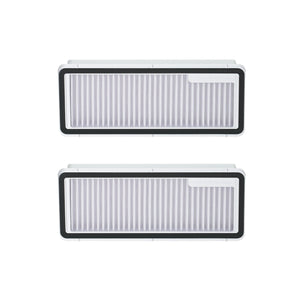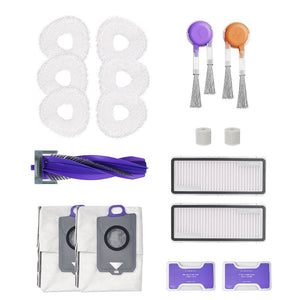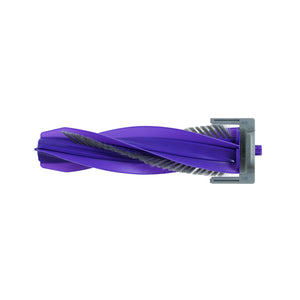The key is syncing it with your smart home system to unlock features like voice control, scheduled cleaning, and room-specific mapping. By connecting it to Wi-Fi, using voice assistants like Alexa or Google Assistant, and customizing your home’s layout for easier navigation, you’ll get cleaner floors with less effort. In this guide, we’ll walk you through how to sync your robot vacuum with your home, use smart scheduling and automation, optimize your layout, keep your vacuum in top shape with battery maintenance and app alerts, and take advantage of advanced features like mapping and data analytics. Ready to get more out of your cleaning routine? Let’s get started.
Sync Your Robot Vacuum with Your Home
Connecting your robot vacuum to other smart devices in your home is key to boosting its performance. Here's how you can make it happen:
Linking Your Robot Vacuum to Your Home Wi-Fi Network
-
Get the app: Download the corresponding app for your vacuum brand (e.g., Narwal).
-
Pair the Vacuum: Power on the vacuum and put it into pairing mode (usually indicated by a blinking light).
-
Link to Wi-Fi: Launch the app, navigate to settings, choose your Wi-Fi, and input the password.
Verify Connection: After connecting, the app will display the vacuum’s status.
Smart Speakers and Voice Assistants: Effortless Voice Command Control
Connect your vacuum to voice assistants like Amazon Alexa or Google Assistant for effortless control.
For Amazon Alexa:
-
Enable Skill: In the Alexa app, search for your vacuum's skill (e.g., "Narwal").
-
Link Account: Sign in to your vacuum’s account and enable the skill.
-
Voice Command: Say commands like “Alexa, start the vacuum” to control your robot vacuum.
For Google Assistant:
-
Link Device: In the Google Home app, link your vacuum.
-
Voice Command: Use commands like “Hey Google, start cleaning.”
Syncing with Other Smart Devices: Enhancing Efficiency
You can also sync your robot vacuum with other devices for automatic and more efficient cleaning. Smart lights can activate the vacuum as soon as you step out of the house. Similarly, door sensors can keep your vacuum from cleaning certain rooms.
To sync with smart lights:
-
Use Smart Home Platform: Link your vacuum to Alexa or Google Home for easy control.
-
Automate Actions: Set routines that trigger your vacuum to clean when you leave, based on lighting patterns.
Integrating your robot vacuum with smart devices helps save time and ensures your home is always clean with minimal effort.
Optimizing Your Cleaning Process with Smart Scheduling and Automation
Once connected to your smart home, you can use scheduling and automation features to optimize your robot vacuum’s cleaning process.
Scheduling Cleaning Times
Set your vacuum to clean automatically during the times that fit your routine. Most vacuums allow you to schedule cleaning for specific days and hours.
Steps to Set a Schedule:
-
Open the vacuum’s app and select the "Schedule" option.
-
Set the cleaning days and times (e.g., every weekday at 9 a.m. or on weekends at 10 a.m.).
-
Save the settings, and your vacuum will start cleaning on its own.
Recommended Schedule:
-
Weekdays: Clean at 9:00 a.m. while you're at work.
-
Weekends: Clean at 10:00 a.m. for regular maintenance.
Further Reading: How to Program Your Robot Vacuum for Scheduled Cleaning
Automating Cleaning Modes
Smart vacuums allow automatic adjustments based on the cleaning conditions. For example, if it detects a dirtier area, it will switch to a higher suction mode without you needing to intervene.
Cleaning Mode Suggestions:
-
Quiet Mode: For light daily cleaning or when you’re home.
-
Powerful Mode: For more thorough cleaning on carpets or high-traffic areas.
-
Deep Clean Mode: For extra suction in areas with heavy dirt buildup.
By automating these modes, your robot vacuum adjusts itself for maximum efficiency.
Using Voice Control for Seamless Operation
Controlling your robot vacuum with your voice is quick and simple. Just use a few commands to turn it on, pause it, or send it back to its charger—no need for buttons.
Common Voice Commands:
-
Alexa Command: “Alexa, tell the robot to start cleaning the living room.”
-
Google Assistant Command: “Hey Google, pause the vacuum.”
-
Alexa Command: “Alexa, stop cleaning and send the vacuum back to the dock.”
-
Google Assistant Command: “Hey Google, make the vacuum clean the kitchen.”
Other Useful Voice Commands:
-
Start/Stop Cleaning: “Alexa, start cleaning.” / “Hey Google, stop cleaning.”
-
Return to Dock: “Alexa, return to the charging station.” / “Hey Google, have the vacuum return to its charging station.”
-
Set Cleaning Schedule: “Alexa, schedule cleaning for 8 a.m. every Monday.”
-
Pause or Resume: “Alexa, pause cleaning.” / “Hey Google, resume cleaning.”
Voice control allows you to manage cleaning sessions while you’re cooking, working, or even when you’re not at home. It simplifies your daily tasks, allowing you to keep your home clean effortlessly without having to do any work.
Optimizing Your Home’s Layout for Smart Cleaning
A robot vacuum performs best in a home environment that minimizes unnecessary obstacles. Optimizing your home’s layout helps your robot move more freely and clean more efficiently.
Keep Pathways Clear
Ensure that floors are free from clutter like shoes, toys, loose cables, or small rugs that could confuse or trap the robot. A clear path allows the vacuum to navigate seamlessly and reduces the chances of getting stuck.
Keep Doors Fully Open
Many robot vacuums rely on mapping or sensor-based navigation. A partially closed door can appear as a wall or confuse the vacuum’s route logic. Keeping doors fully open ensures the robot can enter and clean intended rooms properly.
Use Physical or Virtual Boundaries
Use magnetic strips or in-app "no-go zones" to prevent the robot from accessing certain areas—like near pet bowls, delicate furniture, or staircases. These barriers give the robot clear rules for where to go, improving cleaning precision and avoiding mishaps.
Battery Maintenance and Best Practices
While modern robot vacuums are built to manage charging automatically, a few good habits can significantly extend battery lifespan and performance.
Avoid Constant Overcharging
If your vacuum doesn’t have overcharge protection, avoid leaving it on the charging dock 24/7. It’s generally safe to leave it plugged in overnight or until fully charged, but unplugging occasionally can prevent battery wear.
Let the Battery Cycle Occasionally
Every few weeks, let the battery discharge down to 20% or lower before recharging. This helps calibrate battery sensors and can extend the overall battery life, especially for lithium-ion models.
Use the Right Charger
Always use the original charging dock and adapter that came with your robot vacuum. Third-party chargers may not provide consistent voltage and can damage the battery or charging system over time.
Leveraging App Alerts for Troubleshooting
The mobile app isn’t just for starting or scheduling cleanings—it’s a powerful diagnostic tool that helps you stay informed about your vacuum’s status.
Monitor Real-Time Notifications
Most robot vacuum apps will send push alerts if something goes wrong—like if the vacuum is stuck, brushes are tangled, or the dustbin is full. Responding to these alerts promptly can prevent wear and tear or cleaning interruptions.
Understand Error Codes
Some vacuums display numeric or color-coded error messages in the app or on the vacuum itself. Refer to the user manual or app help center to decode these messages and take the appropriate action.
Maintenance Reminders
Many apps will notify you when it’s time to clean the filter, replace the brush, or perform other maintenance tasks. These reminders are based on usage time and sensor data, making them more accurate than manual tracking.
Advanced Features for Optimizing Your Vacuum’s Performance
Modern robot vacuums come with advanced features that can significantly boost their performance. These features leverage technology to make cleaning more efficient and tailored to your home’s needs.
Mapping and Learning from Your Home’s Layout
Many advanced robot vacuums use mapping technology to learn and memorize the layout of your home. Here’s how this works:
-
Creating a Map of Your Home: When you first use your vacuum, it will map out your home using sensors and cameras. This process may take a few cleaning sessions as the robot explores different rooms and areas of your house. The robot generates a digital map of your space to determine the most efficient cleaning paths.
-
Avoiding Obstacles: The vacuum’s mapping ability helps it recognize obstacles like furniture, walls, and even small items on the floor. Over time, the vacuum improves its cleaning routes by avoiding obstacles and efficiently covering the floor.
-
Setting up Virtual Boundaries: Some high-end models let you define areas that the vacuum should avoid. These are invisible walls the vacuum cannot cross. For example, if you don’t want your robot to enter the kitchen, near delicate furniture, or into the kids' playroom, you can create these no-go zones through the app.
-
Optimized Cleaning Paths: As the vacuum learns your home’s layout, it gets better at planning its cleaning paths. For example, if it notices that a particular area is frequently dirty (like the living room), it will focus more time and energy there, ensuring thorough cleaning.
How to Configure and Utilize Mapping Functions
-
Step 1: Install the vacuum and connect it to your app.
-
Step 2: Allow the vacuum to complete a full cleaning session to generate a map.
-
Step 3: After the map is created, use the app to set no-go zones, such as around fragile furniture or in rooms you want to exclude.
-
Step 4: Review and adjust the map as needed to optimize cleaning paths for the robot.
Data Analysis for Performance Optimization
Some high-end robot vacuums don’t just clean—they collect data on your home’s cleanliness and adjust their performance accordingly. Here’s how this feature enhances your vacuum’s efficiency:
-
Data Collection: The robot collects data during each cleaning session, such as how much dust, dirt, or pet hair is on the floor. It may also track areas of the home that tend to get dirtier faster, like high-traffic zones (hallways, living rooms, etc.).
-
Smart Cleaning Decisions: Based on the data it collects, the vacuum will adjust its cleaning routine. For example, if it detects more dirt in a specific area, it might clean there more frequently. Conversely, it might reduce cleaning sessions in areas that remain cleaner (like guest rooms or storage areas).
-
Energy Efficiency: By collecting real-time data, the vacuum can adjust its cleaning frequency to save energy. Instead of cleaning the same amount every time, it will optimize when to clean based on the data, ensuring better energy usage and battery life.
-
Customizing Cleaning Schedules: Some vacuums offer settings where you can choose different cleaning frequencies for different rooms. For example, you can set the vacuum to clean the living room more often (due to pet hair or heavy traffic) while scheduling less frequent cleaning for other, less-used rooms.
How to Use Data Analytics for Optimization:
-
Step 1: Connect the robot vacuum to your app and enable data tracking features.
-
Step 2: Observe the data on dirt levels collected by the vacuum in different areas of your home.
-
Step 3: Adjust the cleaning schedule based on these data insights. For example, increase cleaning frequency for high-traffic areas.
-
Step 4: Set energy-saving modes based on data analytics to optimize the vacuum’s battery life and cleaning efficiency.
Keeping Your Robot Vacuum Seamlessly Connected to Your Smart Home
Regular upkeep is key to ensuring your robot vacuum operates at peak efficiency. Here’s how to ensure it continues to work seamlessly with your smart home setup:
-
Make Sure to Update the Firmware: Regularly update your vacuum's software to maintain smooth integration with your smart devices.
-
Clean the Sensors and Brushes: Dirt and debris can clog up the vacuum’s sensors and brushes, affecting its performance. Frequent cleaning keeps it running at its best.
-
Monitor the App for Alerts: Many robot vacuums have mobile apps that alert you if there’s an issue. Pay attention to these alerts to keep the vacuum working smoothly.
The Best Robot Vacuums for Smart Homes
If you're looking to make your smart home even smarter, Narwal's latest robot vacuums are some of the best companions you can bring in. They don't just clean—they understand, adapt, and quietly get the job done while you focus on everything else.
Freo Z10: Smart, Gentle, and Hands-Free
Freo Z10 is like having a thoughtful helper at home. It scrubs your floors with the care of a human hand, especially around tricky corners, and handles pet hair without tangling up. It senses how dirty a space is and adjusts itself, even doing extra passes where needed. And when it's done, it washes and dries its mop with warm water, keeping everything fresh without you lifting a finger.
[cta:narwal-freo-z10-robot-vacuum-mop]
Freo Z Ultra: AI-Powered and Always One Step Ahead
Freo Z Ultra adds another layer of intelligence with dual HD cameras and powerful AI that recognizes what’s around it—furniture, wires, pet messes—and responds in real time. It knows when to vacuum, when to mop, and how to do both without spreading dirt. Its base is whisper-quiet, self-cleaning, and smart enough to decide when the job really is done. It’s the kind of vacuum that feels more like a cleaning partner than a machine.
[cta:narwal-freo-z-ultra-robot-vacuum-mop]
Whether you choose the Freo Z10 or go all-in with the Z Ultra, your smart home will thank you—and your floors will too.
Conclusion
When your robot vacuum truly syncs with your smart home, cleaning becomes effortless, efficient—and almost invisible. It's not just about automation; it's about reclaiming time, enjoying a cleaner space, and trusting that the work gets done without you lifting a finger.
Smart cleaning should feel natural. Now it can.
Ready to upgrade how your home cleans itself?
Explore Narwal’s smart solutions today—built to think ahead and clean like a pro.

























































